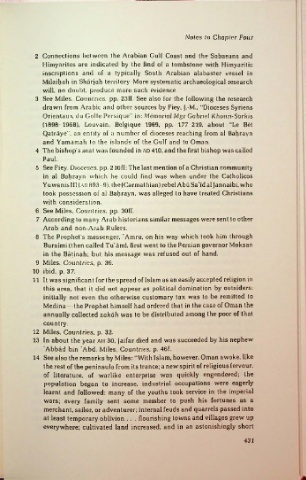Page 457 - Truncal States to UAE_Neat
P. 457
Notes to Chapter Four
2 Connections between the Arabian Gulf Coast and the Sabaeans and
Himyarites are indicated by the find of a tombstone with Himyaritic
inscriptions and of a typically South Arabian alabaster vessel in
Milaihah in Sharjah territory. More systematic archaeological research
will, no doubt, produce more such evidence.
3 See Miles, Countries, pp. 23ff. See also for the following the research
drawn from Arabic and other sources by Fiey, J.-M., “Dioceses Syriens
Orientaux du Golfe Persique" in: Memorial Mgr Gabriel Khouri-Sarkis
(1898-1968), Louvain, Belgique 1969, pp. 177-219, about “Le Bet
Qatraye", an entity of a number of dioceses reaching from al Bahrayn
and Yamamah to the islands of the Gulf and to Oman.
4 The bishop’s seal was founded in ad 410, and the first bishop was called
Paul.
5 See Fiey, Dioceses, pp. 210ff; The last mention of a Christian community
in al Bahrayn which he could find was when under the Catholicos
Yuwanis III (ad 893-9), the(Carmathian) rebel Abu Sa'Id al Jannaibi, who
took possession of al Bahrayn, was alleged to have treated Christians
with consideration.
6 See Miles, Countries, pp. 30ff.
7 According to many Arab historians similar messages were sent to other
Arab and non-Arab Rulers.
8 The Prophet’s messenger, 'Amru, on his way which took him through
Buraimi (then called Tu’am), first went to the Persian governor Moksan
in the Batinah; but his message was refused out of hand.
9 Miles, Countries, p. 36.
10 ibid, p. 37.
11 It was significant for the spread of Islam as an easily accepted religion in
this area, that it did not appear as political domination by outsiders:
initially not even the otherwise customary tax was to be remitted to
Medina—the Prophet himself had ordered that in the case of Oman the
annually collected zakah was to be distributed among the poor of that
country.
12 Miles, Countries, p. 32.
13 In about the year AH 30, Jaifar died and was succeeded by his nephew
'Abbad bin 'Abd. Miles, Countries, p. 46f.
14 See also the remarks by Miles: “With Islam, however, Oman awoke, like
the rest of the peninsula from its trance; a new spirit of religious fervour,
of literature, of warlike enterprise was quickly engendered; the
population began to increase, industrial occupations were eagerly
learnt and followed; many of the youths took service in the imperial
wars; every family sent some member to push his fortunes as a
merchant, sailor, or adventurer; internal feuds and quarrels passed into
at least temporary oblivion . . . flourishing towns and villages grew up
everywhere; cultivated land increased, and in an astonishingly short
431
*

